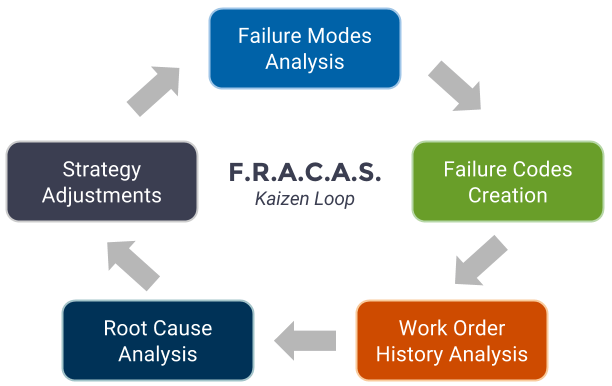
What is a FRACAS, or Failure Reporting, Analysis and Corrective Action System?
FRACAS is the process of reporting and analyzing failures in a designated time frame so that corrective actions can be taken to prevent recurring incidents. It’s a cyclical solution that can help extend the reliability of servicing equipment.
Once FRACAS is integrated into your maintenance strategy, it will also unlock a wide range of other benefits:
- Balanced and accurate KPIs
- Streamlined risk assessments
- Work management automation
The FRACAS system is a closed loop for improving maintenance programs, along with the performance of assets. There are three main sections of failure reporting, analysis, and correction.
What are the Benefits of Applying FRACAS?
The causes of failure become apparent after implementing FRACAS into an asset’s lifecycle, from its inception up to its disposal. In this framework, many processes can be documented as standardized procedures and carried out using your CMMS software. Using the historical data collected from each machine, you can swiftly settle on the right course of action.
One advantage of FRACAS is being able to assess asset performance on demand. Another one is enhancing your reliability programs, and by extension, your asset availability in a way that eliminates risks, by developing structure-to-failure codes. It provides a flow chart for monitoring the results of corrective actions on multiple processes.
The application guidelines will instruct trained personnel on how to collect data for high-priority areas and what equipment redesigns will propel maintenance forward.
The Steps of Every Process in the FRACAS Loop
The so-called FRACAS loop lets your team organize all your reports so you can issue quality assurance checks and update the parts for procurement going forward. For a complete evaluation, be sure to validate what was done during each stage, and make any revisions to the corrective plan as warranted.
1. Failure Mode and Effects Analysis
FMEA, or Failure Modes and Effects Analysis, shows a list of possible failure patterns and their likely outcomes, followed by how to tackle the problem. This gives you an idea of asset criticality, labeled on a priority distribution, and the resources needed to repair a loss of functionality. Failure modes can detect the variation in your PM approach. Specify the potential cause and rate the event’s severity.
2. Failure Code Creation
Failure codes reveal the type of failure that occurred, marked by the component, defect, and cause. It lets you sort failure types to study their change over time — for example, not storing parts to specifications or inadequate personnel training. Failure codes are described in the ISO 14224 checklist. It’s possible to review maintenance KPIs like those for asset health and MTBF by taxonomy.
3. Work Order Analysis
This method divulges the common failures hidden in your work order write-up, represented as failure code frequencies which helps you establish a baseline response against signs of machine damage. Create a failure report template for all your workloads and determine if you’re getting good quality data on your purchases or replacements per year.
4. Root Cause Analysis
This method dives into the underlying causes that are not as obvious, tackling not only the symptoms but also the reason for a slowdown in production. You might discover that the root cause is due to human error or the use of mislabeled parts. The failure analysis report should contain the facility location, event information, and a questionnaire on why it occurred.
5. Strategy Adjustment
To devise a better maintenance strategy, you should draw conclusions from the insights you’ve obtained in the FRACAS previous phases. After root cause analysis, adjust your FMEAs to design a new system for training your technicians. Next, develop the roles and responsibilities for each process, then select what belongs in your policies and procedures manual.
How can a CMMS or EAM work with failure reporting and analysis?
A Computerized Maintenance Management System (CMMS) would indicate what works well and what doesn’t in a PM program and strikes a fair balance between the cost of upkeep and the risk of failure. It fits neatly into the FRACAS paradigm because of the ability to optimize PMs faster without additional planning or assessments. CMMS or EAM tools are already designed for reporting and analyzing failures, easily arranging them in order of importance.
In hindsight, FRACAS classifies common failures to direct operators toward the best solution.
But when combined with CMMS, it forms a strategy for reporting defects, pinpointing the root cause, and recommending corrective actions through KPIs including MTBR and reliability growth. Being more data-driven, the software automates not only work order schedules but also the resources and labor for fulfilling those requests.
What are some examples of FRACAS in action?
FRACAS plays a huge part in preventive and predictive approaches to failure reporting. While your facility has limited resources, you could still make a case for increasing the budget to improve machine performance. If the plant uses poor quality materials for production, this will lower customer satisfaction with products that fail to meet required specs.
Another example is when the bearings are visibly over-greased, which damages and overheats the machine. By referring to the failure codes, you soon realize the root cause is that a technician added a higher volume than the amount expected for lubrication. Calculate the grease volume by bearing size for the grease gun to counteract this.
Finally, FRACAS allows you to narrow down a component’s MTBF. Say you had electrical breakers experiencing failure–you can tell exactly which circuit breakers are no longer detecting overloaded circuits. By heading to the route compliance, you end up seeing a considerable drop in the percentage, confirming that previous inspections were non-compliant.
